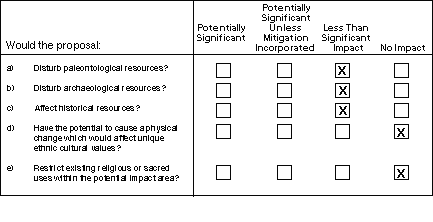
XIV. CULTURAL RESOURCES

b,c) The project site is located entirely within existing road rights-of-way, on PG&E or Santa Clara Valley Water District property, or within the existing PG&E overhead easement. Most of the site has previously been developed. An information search conducted at the Northwest Information Center at Sonoma State University revealed no evidence of cultural resources within a quarter-mile radius of the proposed project (PG&E, 1998). In addition, no site or area listed in or eligible for listing in the National Register of Historic Places occurs within a quarter-mile radius of the proposed project site.
Although the project site is located primarily in areas that have previously been developed, and no cultural resources are known to exist on the site, it is possible that ground-disturbing activities associated with the project could reveal previously undiscovered cultural resources. Impacts on cultural resources are speculative and less than significant; mitigation measures outlined below would further reduce impacts to cultural resources that may be discovered.
No unique ethnic cultural values are attributed to the project site. Therefore, the project would not affect ethnic cultural resources, and no impact would occur.
The project site is not being used for religious or sacred purposes. Therefore, the project would not affect religious or sacred uses, and no impact would occur.
Applicant Proposed Mitigation
The following mitigation measures proposed by PG&E would ensure that all impacts to cultural resources resulting from the project would be less than significant:
Prior to the initiation of construction or ground disturbing activities, all construction personnel will receive environmental training. The training will include discussion of the possibility of buried remains, and the procedure, detailed below, that is to be followed if buried cultural remains are encountered during construction.
If buried cultural materials, including prehistoric and historic resources, are discovered in the project area:
Work in the immediate area of the find will be halted.
PG&E’s archeologist will be notified.
PG&E’s archeologist will identify the find and make the necessary plans for treatment of the find. PG&E’s archeologist will evaluate the find and, if it is found to be historically or culturally significant per CEQA, determine appropriate mitigation measures for review and approval by the CPUC.
If buried human remains are encountered during construction:
Work will halt in the area.
PG&E’s archeologist and the Santa Clara County coroner will be immediately notified.
If the remains are determined to be Native American, the Native American Heritage Commission (NAHC) will be notified within 24 hours as required by Public Resources Code 5097. The NAHC will notify designated Most Likely Descendents who will provide recommendations for the treatment of the remains within 24 hours. The NAHC will mediate any disputes regarding treatment of the remains.
TOP
| Forward to Next Section (Recreation) |
Back to Previous Section (Aesthetics) |
Back to Monta Vista/Wolfe/Stelling Project Main Page | CPUC Environmental Page | CPUC Home Page |